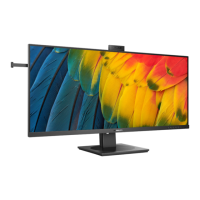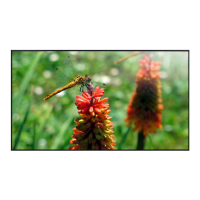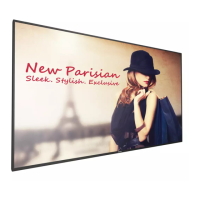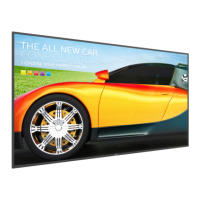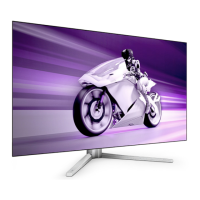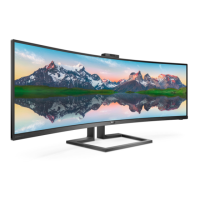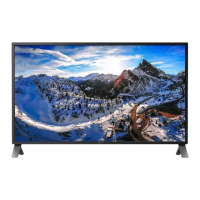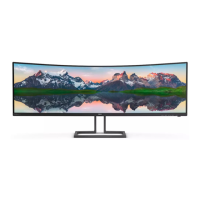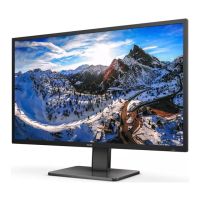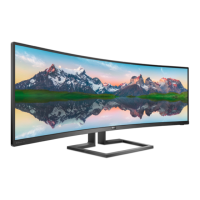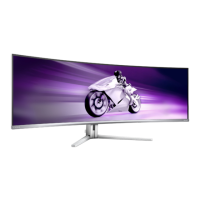Do you have a question about the Philips 40B1U5600 and is the answer not in the manual?
Safety precautions, operation guidelines, and maintenance advice for the monitor.
Explains icons like Note, Caution, and Warning used in the document.
Guidance on proper disposal of the product and packaging according to environmental regulations.
Steps for installing the monitor base and stand.
Instructions for connecting the monitor to a PC using various cables.
Overview of monitor control buttons and navigating the On-Screen Display (OSD) menu.
Guide on using the MultiClient Integrated KVM switch to control multiple PCs.
How to use the MultiView feature for simultaneous display of multiple sources (PIP/PBP).
Steps for removing the monitor base for VESA mounting compliance.
Explains SmartImage presets for optimizing display based on content type.
Details SmartContrast technology for dynamic contrast and backlight optimization.
Describes the LightSensor feature for automatic brightness adjustment based on ambient light.
Information on Adaptive Sync technology for smooth gaming visuals and compatible hardware.
Guidance on setting up and using HDR on Windows 11/10 systems for enhanced visuals.
Tips for adjusting environment lighting and screen brightness for eye comfort.
Recommendations for good working habits, including taking breaks and eye exercises.
Guidance on maintaining an ideal working posture for comfort and productivity.
Highlights monitor features like anti-glare, flicker-free, LowBlue, and EasyRead for eye comfort.
Explains the principle of operation for the PowerSensor user-presence detection feature.
Details default and custom settings for PowerSensor detection range and signal strength.
Instructions on fine-tuning PowerSensor detection settings via the OSD menu.
Details display panel type, resolution, refresh rate, color depth, and picture enhancement features.
Lists signal input sources and physical connectors like HDMI, DP, USB-C, and USB-A.
Information on USB port capabilities, including power delivery and data transfer.
Details power delivery specifications and power consumption in various operating modes.
Lists convenience features and stand adjustment specifications like tilt and swivel.
Provides physical dimensions, weight, operating conditions, and environmental compliance.
Defines power states (Active, Sleep, Off) and their corresponding power usage and LED colors.
Lists the setup configuration used to measure power consumption on the display.
Explains Philips' policy on acceptable pixel and sub-pixel defects for warranty claims.
Classifies pixel defects into Bright Dot Defects and Black Dot Defects with examples.
Lists acceptable levels for bright and black dot defects to qualify for warranty service.
Information on warranty coverage, extended warranty options, and how to contact customer support.
Provides solutions for common issues like no picture and visible smoke or sparks.
Solutions for image issues like blurriness, distortion, and burn-in.
Answers common questions about resolution, drivers, color settings, and refresh rates.
Answers frequently asked questions specifically about the MultiView feature.
| Haze rate | 25 % |
|---|---|
| Color depth | 8 bit |
| Pixel pitch | 0.26925 x 0.26925 mm |
| Screen shape | Flat |
| Pixel density | 94 ppi |
| Backlight type | W-LED |
| Display diagonal | 40 \ |
| Surface hardness | 3H |
| Anti-glare screen | Yes |
| Display technology | LCD |
| Native aspect ratio | 21:9 |
| Vertical scan range | 48 - 100 Hz |
| Horizontal scan range | 30 - 160 kHz |
| NTSC coverage (typical) | 102 % |
| Viewable size, vertical | 387.72 mm |
| sRGB coverage (typical) | 121 % |
| Contrast ratio (dynamic) | 50000000:1 |
| Contrast ratio (typical) | 1200:1 |
| Display number of colors | 16.7 million colors |
| Viewable size, horizontal | 926.22 mm |
| Digital vertical frequency | 48 - 120 Hz |
| Digital horizontal frequency | 30 - 190 kHz |
| Display brightness (typical) | 500 cd/m² |
| High Dynamic Range (HDR) technology | DisplayHDR 400 |
| Dynamic contrast ratio marketing name | SmartContrast |
| Delta E | 2 |
| Picture enhancement | SmartImage |
| Exterior finish type | Textured |
| Regulatory Approvals | CB; CE Mark; FCC Class B; ICES-003; CU-EAC; EAEU RoHS; SEMKO; TUV Ergo; TUV/GS; cETLus |
| Philips SmartUniformity | 93 - 105 % |
| Recyclable packaging material | 100 % |
| Mean time between failures (MTBF) | 70000 h |
| Component video sync | Separate sync |
| Compatible operating systems | Mac OS X Windows 11 / 10 / 8.1 / 8 / 7 |
| HDCP version | 1.4/2.2 |
| Headphone out | - |
| USB hub version | 3.2 Gen 1 (3.1 Gen 1) |
| DisplayPort version | 1.4 |
| USB upstream port type | USB Type-B, USB Type-C |
| USB Power Delivery up to | 100 W |
| USB Type-A downstream ports quantity | 4 |
| RMS rated power | 10 W |
| LED indicators | Operation, Stand-by |
| Tilt angle range | -5 - 30 ° |
| Height adjustment | 150 mm |
| Cable lock slot type | Kensington |
| Panel mounting interface | 100 x 100 mm |
| On Screen Display (OSD) languages | CHI (SIMPL), CHI (TR), CZE, DEU, DUT, ENG, ESP, FIN, FRE, GRE, HUN, ITA, JPN, KOR, POL, POR, RUS, SWE, TUR, UKR |
| Cables included | HDMI, DisplayPort, USB Type-C, AC |
| Bundled software | SmartControl |
| AC input voltage | 100 - 240 V |
| Power supply type | Internal |
| AC input frequency | 50 - 60 Hz |
| Energy efficiency scale | A to G |
| Power consumption (standby) | 0.4 W |
| Power consumption (typical) | 36 W |
| Package depth | 226 mm |
| Package width | 1070 mm |
| Package height | 507 mm |
| Package weight | 17650 g |
| Operating altitude | 0 - 3658 m |
| Non-operating altitude | 3658 - 12192 m |
| Storage temperature (T-T) | -20 - 60 °C |
| Operating temperature (T-T) | 0 - 40 °C |
| Operating relative humidity (H-H) | 20 - 80 % |
| Doesn't contain | Mercury (element), PVC/BFR |
| Sustainability certificates | ENERGY STAR, RoHS |
| Front bezel color | Black |
| Market positioning | Business |
| Depth (with stand) | 280 mm |
|---|---|
| Width (with stand) | 944 mm |
| Height (with stand) | 628 mm |
| Weight (with stand) | 13940 g |
| Depth (without stand) | 54 mm |
| Height (without stand) | 419 mm |
| Weight (without stand) | 9720 g |
